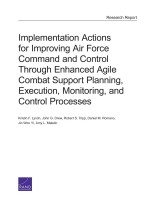| 来源类型 | Research Reports
|
| 规范类型 | 报告
|
| ISBN | 9780833081414
|
| 来源ID | RR-259-AF
|
| Implementation Actions for Improving Air Force Command and Control Through Enhanced Agile Combat Support Planning, Execution, Monitoring, and Control Processes |
| Kristin F. Lynch; John G. Drew; Robert S. Tripp; Daniel M. Romano; Jin Woo Yi; Amy L. Maletic
|
| 发表日期 | 2014
|
| 出版年 | 2014
|
| 页码 | 82
|
| 语种 | 英语
|
| 结论 |
There are gaps and shortfalls in many areas, including process; doctrine, guidance, and instructions; training and career management; and tools and systems.- In the process area, the overarching shortfall is the inability to provide an enterprise assessment of combat support capabilities and constraints to inform trade-off decisions.
- Currently, doctrine and policy do not clearly define and delineate the command and control roles and responsibilities of combat support organizations.
- Trained personnel are necessary to help remedy shortfalls by conducting integrated capability assessments and developing scarce resource allocation schemes.
- Models and tools are needed to help relate combat support resource levels and process performance to operationally relevant metrics.
While the Air Force has taken steps to address these shortfalls, some goals still need to be met.- Global capabilities need to be assessed in a standard, repeatable manner that is linked directly to the ability to meet operational requirements.
- The results of individual supply chain and functional capability assessments need to be integrated and balanced into a set of capabilities that can be used in planning and replanning processes.
- There should be a defined process to arbitrate between and among competing operational demands.
- Codifying processes in doctrine, guidance, and instructions would help to institutionalize process improvements.
|
| 摘要 |
- To begin addressing these challenges, the Air Force could call a command and control (C2) symposium, bringing together Air Force communities that play key roles in this area to define assessment and control technique requirements; vet capabilities; identify necessary changes in doctrine, guidance, and instructions; develop needed training enhancements; and define organizational roles and responsibilities.
- Codify new processes in doctrine and guidance.
- Delineate the roles and responsibilities of each C2 node, including logistics, operational, and installation staff; Air Force commanders; MAJCOMs; and others, in doctrine and guidance.
- Identify a commander who can be given the authority to move the Air Force toward an integrated C2 vision enhanced by agile combat support processes.
|
| 主题 | Combat Support Operations
; Military Command and Control
; Military Force Planning
; United States Air Force
|
| URL | https://www.rand.org/pubs/research_reports/RR259.html
|
| 来源智库 | RAND Corporation (United States)
|
| 资源类型 | 智库出版物
|
| 条目标识符 | http://119.78.100.153/handle/2XGU8XDN/107696
|
推荐引用方式
GB/T 7714 |
Kristin F. Lynch,John G. Drew,Robert S. Tripp,et al. Implementation Actions for Improving Air Force Command and Control Through Enhanced Agile Combat Support Planning, Execution, Monitoring, and Control Processes. 2014.
|
|
文件名:
|
x1495315145574.jpg
|
|
格式:
|
JPEG
|

|
文件名:
|
RAND_RR259.pdf
|
|
格式:
|
Adobe PDF
|
除非特别说明,本系统中所有内容都受版权保护,并保留所有权利。